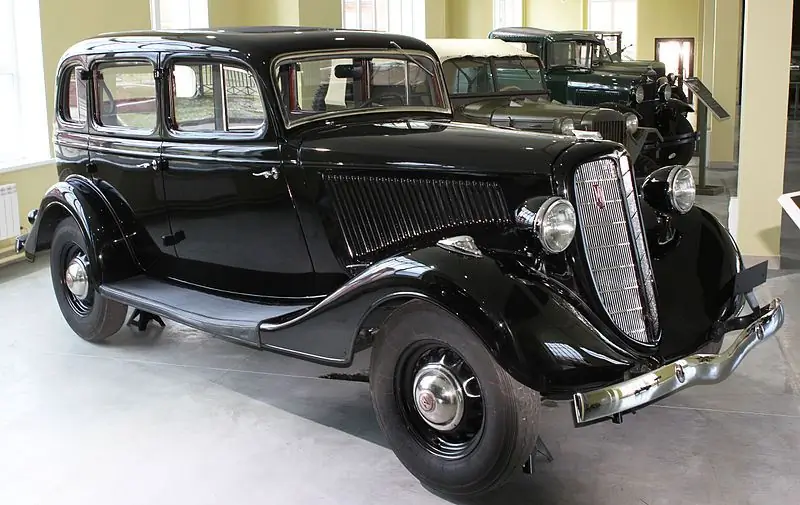2025 Author: Erin Ralphs | [email protected]. Last modified: 2025-01-22 21:14:12
In the late 70s, the bulk of the new trucks in the USSR were cars equipped with gasoline engines. The production of diesel trucks was only gaining momentum and was carried out at a single plant in Naberezhnye Chelny. As an alternative solution, the GAZ and ZIL plants began to develop vehicle modifications adapted to work on compressed or liquefied gas.
Liquefied petroleum gas was noticeably cheaper than gasoline and could provide a significant reduction in exhaust emissions. Gas trucks were used in fairly large cities equipped with special gas stations. Another place of application of such machines was the fleet of oil and gas developments.
Based on ZIL-130
One of these vehicles was the onboard vehicle ZIL 138, which was a gas-cylinder modification of the model 130 truck. A mixture of liquefied petroleum gases - propane and butane - was used as the main fuel. The engine had a backup fuel supply system with gasolineA76, which was used for starting and warming up. Serial production of machines began in 1977 and continued until 1986. The exact number of machines manufactured is not known, since the plant produced a set of parts for the conversion of machines. This work was carried out by the motor companies themselves. An early prototype LPG truck is pictured.

One of the main differences was the installation of a specialized engine with an increased compression ratio and special devices that provide fuel supply. Externally, the car is easy to distinguish by the installed bright red gas cylinder. A cylinder with a volume of 225 liters was placed on the left side member of the frame, in place of the standard 150-liter gas tank. Liquefied gas was in a cylinder at a pressure of 16 atm. The cylinder had a special filling valve and a safety device. The gas level was controlled by a special sensor. The installation of gas supply equipment increased the curb and gross weight of the flatbed truck by 115 kg.
Modifications
A whole family of cars was created on the basis of the ZIL-138 gas-balloon onboard vehicle. The onboard version with a standard wheelbase of 3800 mm could be shipped to customers in the form of a bare chassis for the installation of various specialized superstructures. In addition to the base machine, the most common were a truck tractor under the designation 138V1 and a chassis for the manufacture of construction dump trucks 138D2. These variants had a wheelbase shortened to 3300 mm and two liquefied gas cylinders each. Cylinders have reduced to 117,4 liters volume and located behind the cab on the frame spars.
The tipper chassis was slightly different with additional options. Among them were a redesigned brake valve and a tow hook with adjacent connectors for connecting the trailer's electrical and pneumatic systems. Such a chassis served as the base for the MMZ 45023 dump truck. The truck tractor could be operated with semi-trailers of various brands with a gross weight of not more than 14,000 kg.

Features of the power plant
The eight-cylinder V-engine of the Soviet truck ZIL 138 was based on a standard model 130 gasoline engine. The main fuel was the so-called "technical propane" or "liquefied hydrocarbon gas", which had a standard composition and was produced by oil refineries. The compression ratio was increased to 8 units (from 6.5 on the 130th engine), which made it possible to maintain power and traction characteristics at the level of gasoline counterparts. Serial ZIL-138 - in the photo below.

Fuel supply
On a gasoline engine, a carburetor is used to prepare the mixture, which is not suitable for supplying gas. The initial stage of preparation of the fuel mixture is the conversion of the fuel from the liquid phase to the gaseous state. The gas in the cylinder is in liquid and gaseous state. A mixture of gas phases enters the main pipelines through flow valves. Each gas phase had its own valve. After passing through the main valve, the gasfiltered from mechanical particles and suspensions of resinous substances. The replaceable felt filter is made in one housing with a solenoid valve and is installed on the engine bulkhead of the cab.
Then the gas enters a special evaporator, where it completely turns into a gaseous state. The evaporator was located on the engine intake manifold and was heated from the cooling system. After that, the fuel enters the first stage of the gas reducer. There is an additional filter with a replaceable element in front of the first reduction chamber. The reducer is a pressure regulator with two stages. Rubberized diaphragms are installed inside the gearbox, mechanically connected with control valves. The gas, passing through the stages of the reducer, reduces its pressure to the required level. The pressure in the first chamber of the reducer is displayed on a pressure gauge mounted on the dashboard of the machine.
Additionally, in the second chamber of the gearbox there is a device that doses the fuel supply depending on the engine speed. The design of the device has a special solenoid valve that supplies a portion of gas to the mixer when starting a cold engine. The valve is opened with a button from the driver's seat.
The propane that has passed through the reducer enters the mixer installed directly on the engine. The mixer is actually a carburetor of a special design, which provides a mixture of air and gas and feeds it into the engine cylinders. The mixer is equipped with a speed limiter and heating from the engine cooling system.
Next to the faucet installedhorizontal carburetor for a backup gasoline supply system. The design of the gasoline carburetor has two metal mesh flame arresters. Gasoline is supplied by a pump from a separate 10-liter tank installed under the cab floor on the right side.
Compressed gas
In 1982, the base truck of the plant underwent a major modernization aimed at improving operational and technical characteristics. ZIL 138 was modified in a similar way. The base car was optionally equipped with an engine with the ability to run on compressed gas. Such a motor was equipped with a unified cylinder head with a compression ratio of 6.5. Because of this, the power of the power unit did not exceed up to 120 forces. The onboard landing gear was produced in two types:
- with a standard base of 3800 mm and a load capacity of 5200 … 5400 kg (138A);
- with an extended base of 4500 mm and a load capacity of 5000…5300 kg (138AG).
According to special orders, the ZIL-138I variant with a standard base was supplied, equipped with an engine with cylinder heads with a compression ratio of 8 units. The motor developed up to 135 forces when running on gas or up to 160 forces on AI93 gasoline. The variant with an extended base bore the ZIL-138IG index. You can see a general view of the model with gas cylinders in the photo below.

The gas supply was in eight 50-liter cylinders installed across the frame. For safety, the cylinders were divided into two groups, each of which had a separate gas supply valve. With the start of production of 138A, all gastrucks of the ZIL plant received a front side of the platform increased in height. Such a refinement somewhat increased the safety of the cab when the truck rolled over. CNG cars had a standard 150-litre petrol tank.

Small-scale and experienced
In addition to LPG machines, there were options designed to run on compressed gas. All machines were designed and tested in the early 80s.
These were the experimental ZIL-138AB and 138AB, which had a standard base and were equipped with eight cylindrical cylinders for storing fuel. The motors of the machines developed power up to 120 hp. With. Another experimental car was the ZIL-138IB, which had a long base and a 135-horsepower engine with an increased compression ratio.
Recommended:
"Cadillac": country of origin, history of creation, specifications and photos

There are people who are interested in what country is the manufacturer of Cadillac. What is this car famous for? How did its production begin? Who stood at the origins. What are the current popular models? What are their features. Our article answers all these questions
Russian "Hammer": characteristics, photos and history of creation

Russian "Hammer": specifications, base, history of creation, modifications, photos. Russian "Hammer" based on GAZ-66: description, types, operation, stages of creation, features. Russian military "Hammer": parameters, pros and cons
GAZ-11: photo and review of the car, history of creation, specifications and interesting facts

GAZ is the largest automaker that started manufacturing products in the city of Nizhny Novgorod. In the first years of its work, GAZ produced "Ford" products. For the realities of the Russian climate, the engine of this series of cars did not fit well. Our specialists solved the task, as always, quickly and without unnecessary troubles, taking as a basis (actually copying) the new GAZ-11 engine, the American lower-valve Dodge-D5
"Maserati": country of origin, history of creation, specifications, power and reviews with photos

Practically everyone who is interested in cars sooner or later dreamed of a Maserati (manufacturing country - Italy). This luxury car brand inspires admiration and respect for its developers. Read about the history of the brand, about which country the Maserati manufacturer is and about the latest line of these supercars, read in this article
Wheel tractor MAZ-538: description, specifications, purpose and history of creation

Wheel tractor MAZ-538: description, history of creation, design features, photo. MAZ-538: technical characteristics, purpose, device, type of suspension, engine and gearbox

